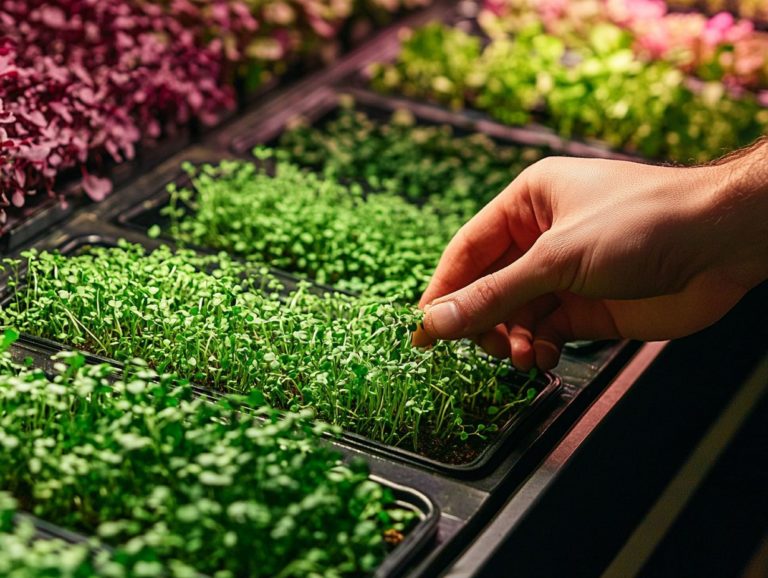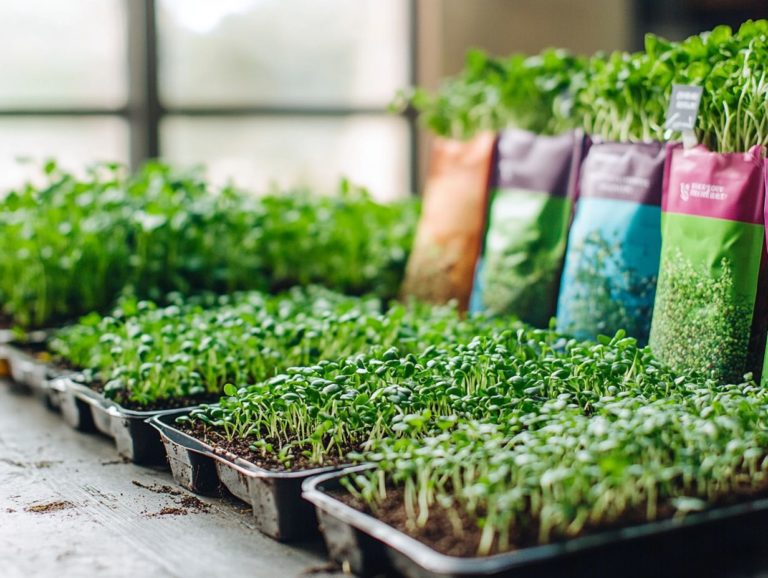How to Build Your Own Microgreen Growing Station
Microgreens are small yet mighty plants that can elevate your culinary endeavors while enhancing your health.
Growing them at home introduces fresh flavors to your dishes and offers a gratifying gardening experience in your home garden.
This guide will walk you through the essentials of setting up your own microgreen growing area, covering everything from choosing the right materials and tools, such as seed trays, to nurturing your greens.
You ll also discover delightful ways to weave these vibrant veggies into your meals.
Ready to grow your green thumb? Let’s jump in and get started!
Contents
- Key Takeaways!
- Benefits of Growing Microgreens
- Choosing the Right Growing Area
- Materials and Tools Needed
- Step-by-Step Guide to Building a Growing Station
- Caring for Microgreens
- Common Issues and Troubleshooting
- Recipes and Ideas for Using Microgreens
- Frequently Asked Questions
- What is a microgreen growing station?
- Why should I build my own microgreen growing station?
- What materials do I need to build my own microgreen growing station?
- How do I set up my microgreen growing station?
- How long does it take to grow microgreens in a growing station?
- Can I reuse the soil in my microgreen growing station?
Key Takeaways!
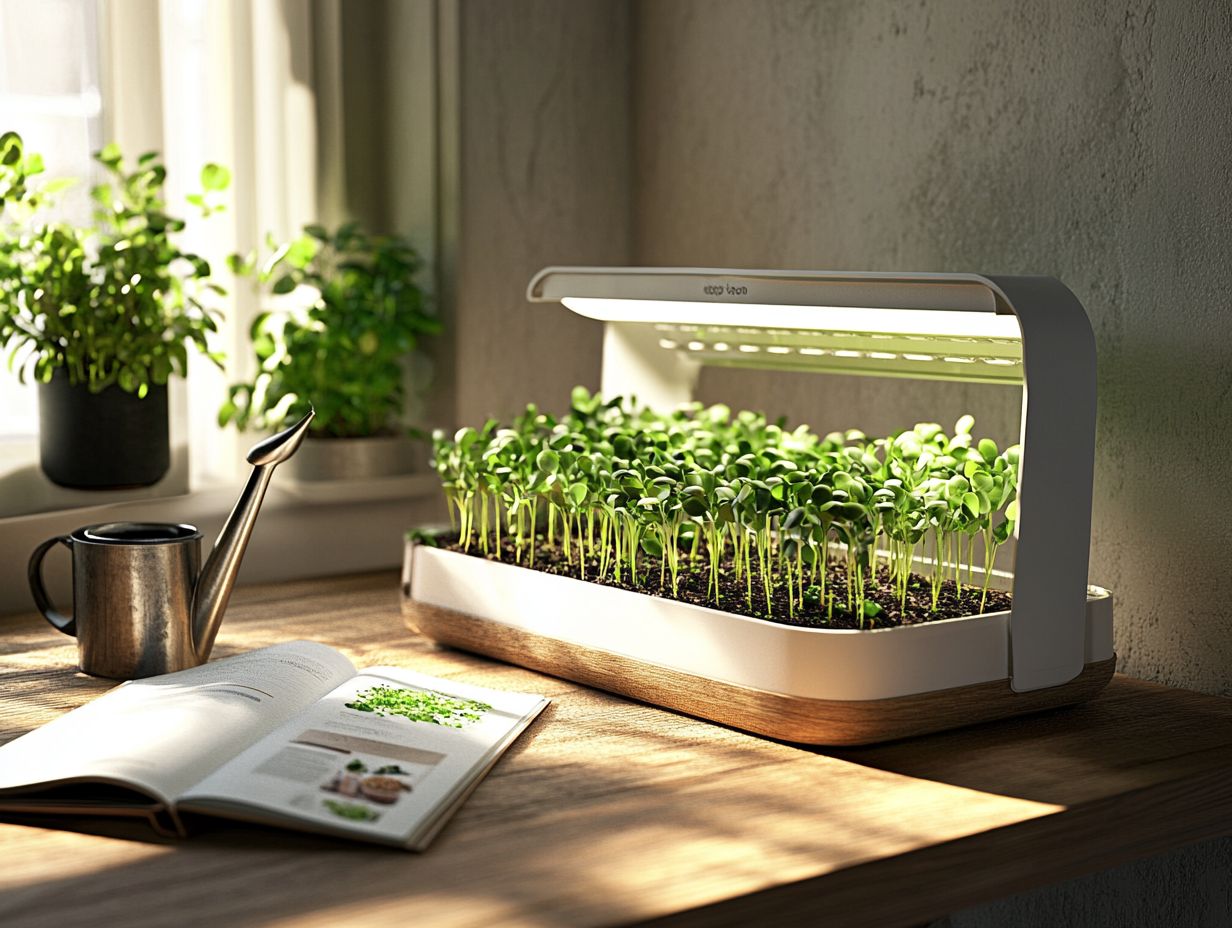
- Grow nutrient-packed microgreens for convenience and taste.
- Choose the right growing area by considering factors like space, budget, and materials.
- Follow our step-by-step guide to building and caring for your own microgreen growing area.
What are Microgreens?
Microgreens are the young seedlings of edible vegetables and herbs that you can harvest just after the first true leaves have emerged. This usually occurs within 7 to 14 days of germination.
Popularized by urban agriculture advocates like Francesco Di Gioia from Penn State, these tiny greens deliver an impressive nutritional boost, brimming with concentrated vitamins and minerals like vitamin C, vitamin K, and iron.
They re incredibly easy to grow in small containers, making them perfect for your home garden or indoor gardening setup, especially if you want to infuse your healthy diet with a fresh, nutrient-dense touch.
With a rich history that dates back to ancient civilizations, microgreens have seamlessly transitioned into a modern culinary staple. Chefs and home cooks alike appreciate them for their vibrant colors and delightful flavors.
Varieties such as radish, broccoli, and basil each bring unique tastes that can elevate your dishes, from salads to gourmet entrees.
You can cultivate these greens both indoors and outdoors, whether in soil or hydroponically. Hydroponics is a method of growing plants without soil, using nutrient-rich water instead, making them suitable for everyone, especially those with limited space.
By emphasizing organic practices, growing microgreens not only supports sustainable gardening but also plays a key role in fostering a healthier lifestyle, bridging the gap between quick food preparation and nutritional excellence while using soil alternatives like hydroponics.
Benefits of Growing Microgreens
Growing microgreens offers many benefits that extend beyond convenience.
These tiny powerhouses are nutrient-dense additions to your healthy diet and easy to cultivate in an urban setting with minimal resources.
This makes them an accessible choice for both novice gardeners just starting out and seasoned green thumbs looking to expand their gardening repertoire.
Nutritional Value and Convenience
Microgreens are celebrated for their exceptional nutritional value, packed with essential vitamins like vitamin C and vitamin K, which are vital for maintaining a healthy diet.
This makes them a favored choice among health-conscious consumers and chefs alike.
Beyond these key vitamins, microgreens offer a wealth of important minerals such as iron, calcium, and magnesium.
Each of these plays a significant role in promoting overall health by bolstering bone strength, enhancing immune function, and supporting muscle recovery.
Growing microgreens at home gives you the power to cultivate fresh, flavorful produce right in your kitchen, ensuring easy access to these nutrient-dense greens.
This home gardening experience deepens your connection to food and supports a nutritious lifestyle, allowing you to incorporate these wholesome ingredients into your daily meals without relying on store-bought options.
Choosing the Right Growing Area
Choosing the perfect growing area for your microgreens is essential for achieving optimal plant growth.
You’ll need to thoughtfully consider factors like the growing medium, light exposure, and water drainage.
Each element plays a vital role in crafting the ideal environment for these vibrant plants to flourish.
Start growing your own microgreens today and enjoy the taste and health benefits!
Factors to Consider
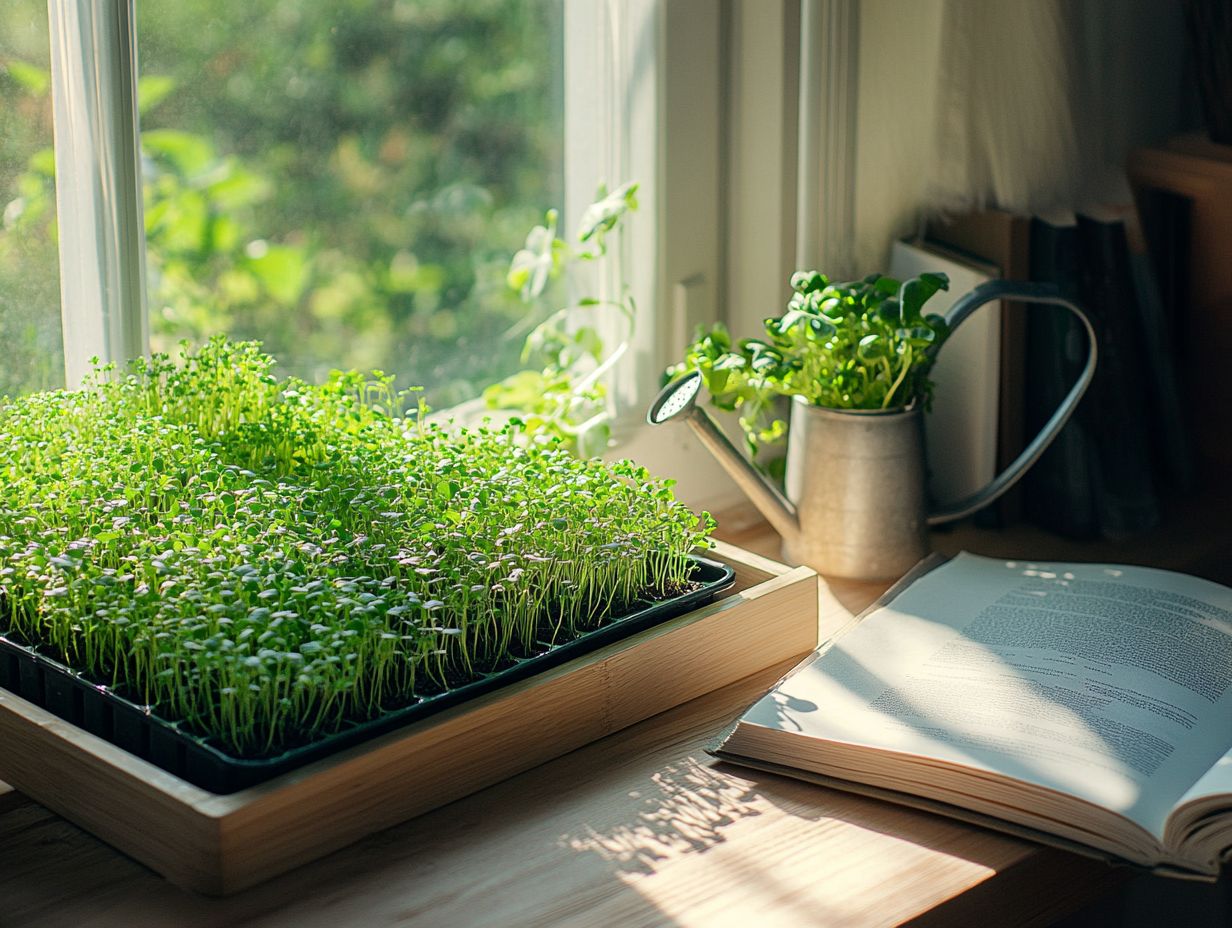
When you re setting up a growing station for microgreens, several essential factors come into play. These include your choice of growing medium, the adequacy of light exposure, and the effectiveness of your water drainage systems.
Each of these elements is crucial in creating a thriving environment for those delicate greens.
You have a variety of growing mediums at your disposal like soil, peat, and perlite which each offer unique benefits. This is especially important when considering soil alternatives for your microgreens. For instance, peat excels at moisture retention, while perlite enhances aeration and drainage.
By understanding the nuances of each medium, you can create a setup that works for you and ensures optimal growth.
Adequate light sources are vital for photosynthesis, the process plants use to convert light into energy. Whether you opt for the full spectrum of natural sunlight or adjustable artificial LED lights, both are effective. Don t overlook water drainage; it s crucial to prevent root rot and ensure proper moisture levels for your microgreens.
You can achieve this by using containers with drainage holes and layering gravel or coarse material beneath your growing medium.
Materials and Tools Needed
To successfully cultivate microgreens at home, gather a few essential materials and tools. This includes scissors and measuring cups for your home cultivation.
Consider investing in seed trays and sourcing high-quality organic seeds. Also, arm yourself with scissors for an efficient harvest.
Don t forget measuring cups to ensure precise management of water and nutrients throughout the growing process. These items are essential for your success.
Essential Supplies for Building a Growing Station
For your microgreens growing station, the essentials include seed trays for planting organic seeds, scissors to make harvesting a breeze, and measuring cups to guarantee precise delivery of water and nutrients throughout the germination process.
Consider adding a spray bottle for misting your microgreens, keeping them hydrated without risking soil oversaturation. A grow light can also be a game-changer, especially if your natural sunlight is lacking, as it provides the illumination necessary for optimal growth. For best practices, refer to this step-by-step guide to sowing microgreens.
Regarding sourcing these supplies, local gardening stores often have a variety of trays and tools tailored for microgreens. Alternatively, online retailers that specialize in home cultivation offer convenient options. They often feature kits that include everything you need to get started, including How to Use Hydroponics for Microgreens, making the process seamless for beginners.
Step-by-Step Guide to Building a Growing Station
When you embark on the journey of creating a thriving microgreens station, careful planning is important. Start by planning your light exposure and setting up efficient water drainage systems.
Plan your light exposure carefully to nurture your greens effectively. Ensure your microgreens flourish in their optimal environment.
Instructions and Tips for Assembly
As you assemble your growing station for microgreens, it s essential to follow detailed instructions. This will elevate your container gardening experience and maximize plant growth.
Start by selecting the right containers. They should feature drainage holes to prevent waterlogging that can jeopardize those delicate seedlings. Arrange your containers thoughtfully to maximize space and allow for adequate air circulation.
Next, set up your lighting system. Utilizing full-spectrum LED grow lights positioned 6-12 inches above the plants can effectively mimic sunlight and promote vigorous growth. To avoid common pitfalls, ensure your lights are adjustable, allowing you to modify the height as your microgreens thrive. For more tips, check out this guide on how to grow microgreens in a small space.
Also, consider using trays with water reservoirs beneath each container. This will help with drainage and keep the roots moist without the risk of oversaturation.
Caring for Microgreens
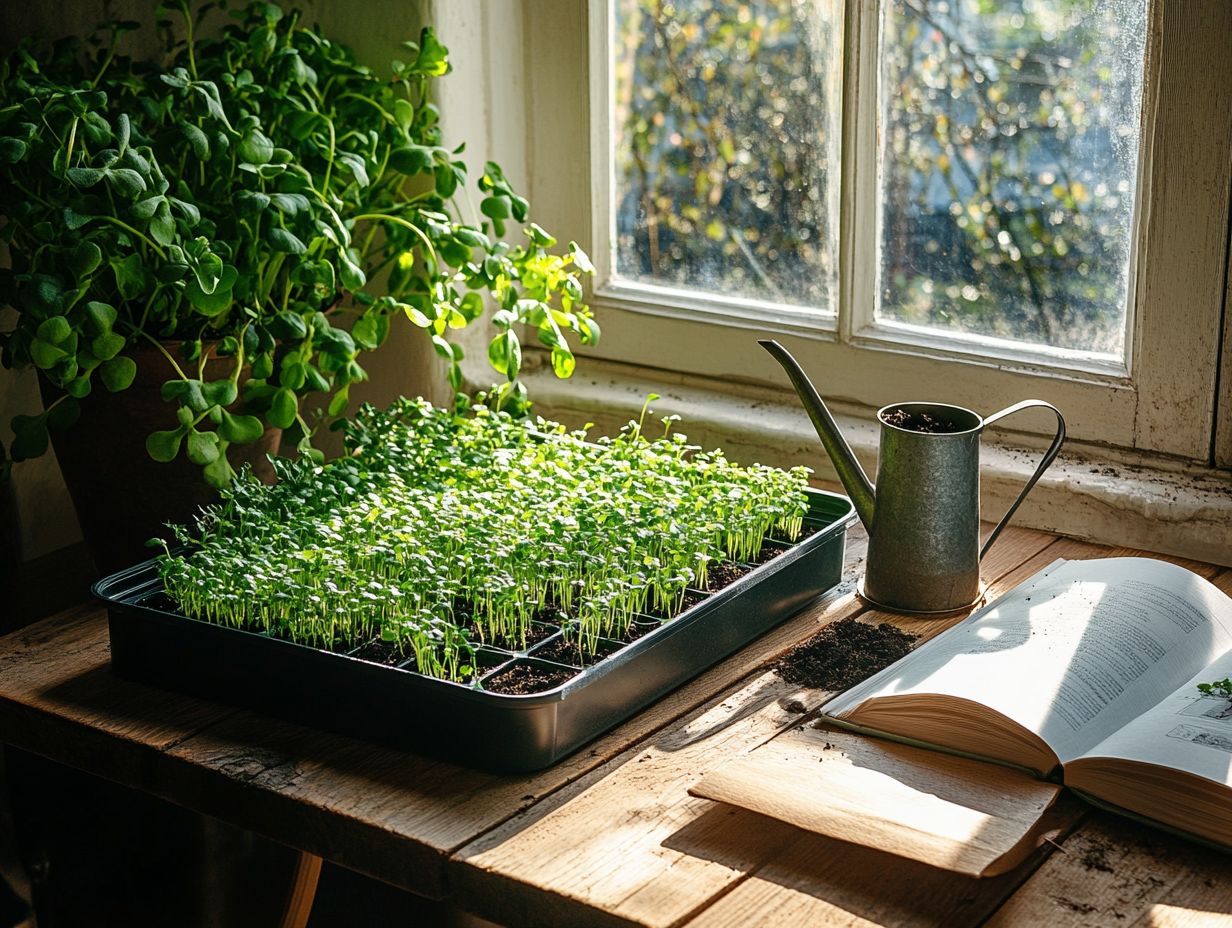
Caring for microgreens requires a few key tasks. You’ll want to master proper watering techniques, ensure timely harvesting, and maintain an ideal growing environment.
These steps are crucial for achieving optimal plant health and maximizing the benefits of your microgreen cultivation.
Watering, Harvesting, and Maintaining
Effective watering, timely harvesting, and consistent maintenance are essential practices that play a pivotal role in successfully cultivating microgreens, especially during the harvesting phase.
Understanding how wet the soil should be is paramount; both overwatering and underwatering can threaten the health of these delicate plants. Microgreens flourish in a balanced environment, and employing a misting technique allows you to achieve optimal moisture without overwhelming the seedlings. For more insights, check out these techniques for growing microgreens year-round.
When it comes to harvesting, timing is everything. Waiting for the first true leaves to emerge is often the best cue to take action. Using clean, sharp scissors will provide a smooth cut that minimizes damage to the plants.
Regular checks for pests and maintaining appropriate humidity levels will help your microgreens grow better, allowing you to enjoy the best from your greens.
Common Issues and Troubleshooting
Despite their resilience, you may encounter common challenges when growing microgreens. Issues related to water drainage, light exposure, and overall plant health can arise, making it essential to implement regular care tips.
Identifying and Solving Problems
Identifying and addressing issues in microgreens cultivation is essential for maintaining their health. It requires keen observation and a solid understanding of the common challenges that can arise during their growth.
For example, inadequate lighting can lead to leggy and weak seedlings. It’s crucial to assess your light source and duration of exposure. Ensuring that your microgreens receive at least 12 to 16 hours of light daily can significantly enhance their growth, and learning how to extend the growing season for microgreens can further improve your results.
Pests like aphids can stealthily undermine your crop, affecting the vigor of your microgreens. Regularly inspecting the foliage for signs of these pests such as tiny spots or sticky residue will allow you to catch them early. Act quickly if you notice pests to protect your greens!
If you do spot them, introducing beneficial insects or employing insecticidal soap can effectively reduce damage, helping to preserve the health of your microgreens.
Recipes and Ideas for Using Microgreens
Incorporating microgreens into your culinary repertoire unlocks a realm of flavor and nutrition. With countless recipes and innovative ideas at your fingertips, you can easily boost your meals with excitement!
Incorporating Microgreens into Meals
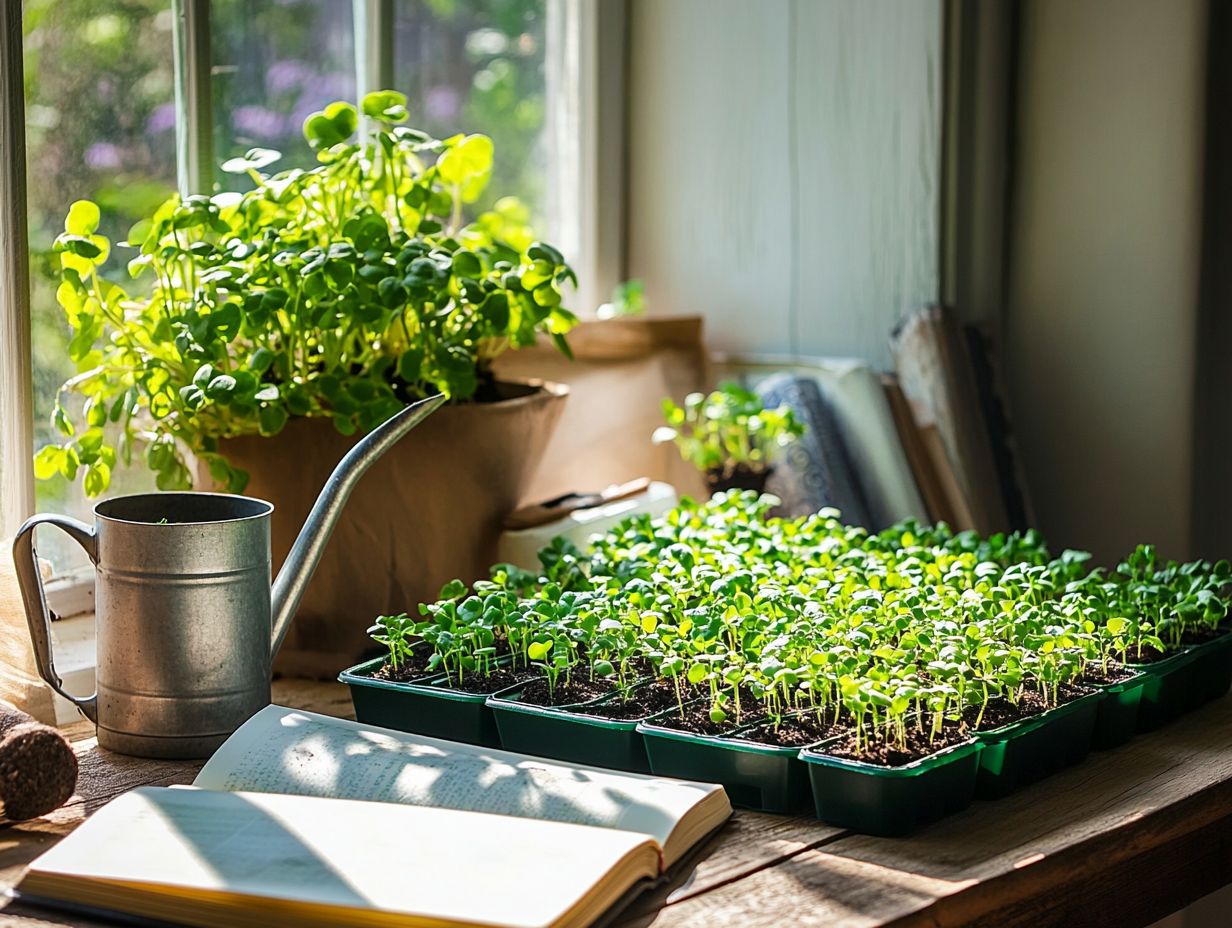
Adding microgreens to your meals is a superb way to elevate both flavor and nutritional value, allowing you to relish the benefits of these nutrient-dense veggies in delightful and innovative ways.
These tiny greens can effortlessly transform ordinary dishes into culinary masterpieces. For instance, toss in a handful of peppery arugula microgreens to your fresh salad to enhance its flavor while infusing it with vitamins A, C, and K. Imagine adding a sprinkle of vibrant radish microgreens to your wraps; they bring a zesty crunch while delivering a healthy dose of antioxidants. As garnishes, delicate pea shoots can elevate the presentation of soups or entrees, making them visually stunning and nutritionally rich.
Each variety boasts its own unique flavors from nutty to spicy broadening your culinary horizons while promoting overall health.
Frequently Asked Questions
Start your microgreen journey today for fresher meals and healthier living!
What is a microgreen growing station?
A microgreen growing station is a compact and controlled environment designed specifically for growing microgreens, which are young, nutrient-rich vegetable greens.
It typically consists of trays, lighting, and a cover to make a mini greenhouse where microgreens can thrive.
Why should I build my own microgreen growing station?
Building your own microgreen growing station gives you complete control over the growing process. This ensures your microgreens are grown in a clean and pesticide-free environment.
You can also save money, as buying microgreens from the store can be expensive!
What materials do I need to build my own microgreen growing station?
You will need a shallow tray, like a seedling tray, a clear plastic lid or cover, and grow lights lights that help plants grow by providing the right spectrum of light.
Additionally, you will need potting soil and microgreen seeds. A heat mat might be necessary to maintain a consistent temperature for optimal growth.
How do I set up my microgreen growing station?
First, fill the tray with potting soil and lightly compact it. Then, sprinkle the microgreen seeds evenly over the soil and lightly cover them with a thin layer of soil.
Place the lid on top and set up the grow lights according to the instructions. Set the timer for 12-16 hours of light per day and place the tray on a heat mat if needed.
How long does it take to grow microgreens in a growing station?
Microgreens typically take 7-14 days to grow, depending on the type of seed and environmental conditions.
You can harvest them once they develop their first true leaves or reach a desired size. Keep an eye on moisture levels, and ensure they get adequate light and warmth for optimal growth!
Can I reuse the soil in my microgreen growing station?
No, it is not recommended to reuse the soil. Microgreens grow quickly and deplete the soil of nutrients.
Starting with fresh potting soil for each new batch of microgreens is the key to thriving plants!





